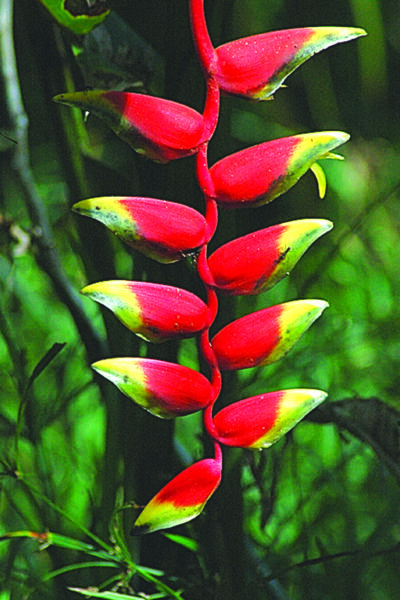
Botany
Botany deals with the study of plants, which can be classified into 2 main groups: vascular and nonvascular.
NON VASCULAR PLANTS
They are those without glasses for driving fluids. They are aquatic or the ones that grow on very moist terrestrial environments, such as Bryophytes (mosses), with more than 1.000 species in Costa Rica, which appear in a variety of ecosystems and grow with an epiphytical shape on branches and trees trunks, rocks or soil.
VASCULAR PLANTS
They have conductive tissues and are differentiated in two groups, those that reproduce by spores, most notably among the Ferns, with over 1.000 species in Costa Rica. They reproduce through seeds, such as Conifers, pines and cypresses including the parrot cypress that lives in the highlands of Talamanca and the Anthophytas which include all the flowering plants and are divided in 2 groups, the Monocotyledons and Dicotyledons.

MONOCOTYLEDONS
In Costa Rica there are more than 2.900 Monocotyledons species, including the most representative family, the Orchids, with more than 1.300 species. You find them in the very humid and rainy, most are epiphytes, living in trees or rocks that serve as support and some are terrestrial. They are distinguished by the complexity of its flowers, which vary from less than 1 mm. to 15 or 20 cm, all of striking colours. They bloom only once a year and can remain open from one day to more than three months. The stems are swollen at the base forming pseudobulbs that can store water and nutrients. Its aerial roots are responsible for capturing the nutrients the plant needs, besides serving as support. Its various forms attract a great variety of insects, birds and bats.
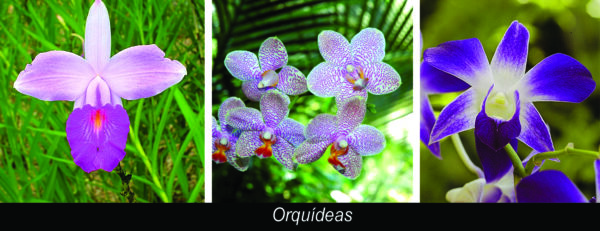
Another very characteristic family of epiphytic plants are the Bromeliaceae, many of them endemic. They are characterized by having the leaves aligned in an overlapping spiral forming a rosette at the base that stores rainwater in its central cavity and are used as habitat and reproduction by many animals. The leaves are serrated, concave and pointy, covered by a sort of scales on their surface that collects water and minerals, as the roots have lost this function and only serve as anchors. The inflorescenses are in posy or spike, and the flowers are pollinated by insects, birds, occasionally by bats, and rarely by the wind.
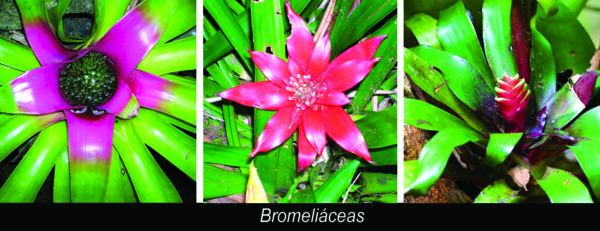
It also highlights the order of Zingiberaceae or Platanillos, among which you find the Musaceae with about 40 species in 3 genuses (Musa, Musella, and Ensete), being the most economically important those that give bananas and plantains for food. The Heliconiaceas are 1 to 7 meters tall, have simple leaves, inflorescences are produced at the end of each stem or plant´s base, they have red, yellow or orange flowers with a nectar that attract hummingbirds, which are associated with these species for pollination. The Zingiberaceae have long leaves and large showy inflorescences of various colors and shapes that are primarily pollinated by insects, bees, moths, butterflies and birds. Many are valuable as spices, including ginger, turmeric and cardamom, and others are used as ornamental plants. The Marantacea (Galatians) are perennial herbaceous plants, provided with rhizomes or tubers, are somehow similar to certain heliconia, but you can distinguish them because their leaves are arranged in two rows with fibers perpendicular to the veins that makes them hard to rip, some close their leaves at night. There are also Cannaes (Cannas and Chirilla) and the Strelitziacaeas (birds of paradise).

Another family are the Araceae, herbaceous plants that can be terrestrial, arboreal or vines with aerial roots, epiphytic or floating aquatic plants, such as the water lilies. They are distinguished by their characteristic inflorescence that sometimes makes believe that it is the flower, which produces a strong odor that attracts its pollinators, such as beetles, flies and bees. Many are used as ornamentals, others are used by the Indians as medicines and for obtaining fibers from their roots. In the Caribbean we find the Philodendron (Philodendron) name that comes from the Greek words phileo, loving, and dendron, tree. They are bushes or small trees which are able to climb over other plants or tree trunks. The leaves are usually large, often lobulated or cleft, as the Monstera deliciosa or the tiquizque. The Anthurium or Aros have thick leaves, oval, heart or arrowhead or hand shaped, the flowers are surrounded by husks, a kind of candle which can be red, yellow, green or white around the spadix, cylindrical inflorescence composed of small flowers that are grouped around a central axis. And the Calas (Zantedeschia), a semi-aquatic herbaceous rhizome with wavy edge leaves, sharpened in the point and with a well pronounced central vein. The inflorescence is white, yellow or pink, its petals are like spathe surrounding the spadix, in other words, the erect floral organ that is yellow.
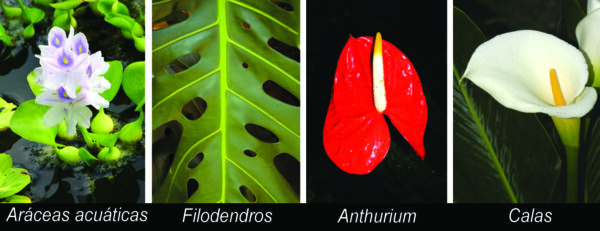
In the Malvaceae family the Hibiscus outstand, from bushes to small trees with simple alternate leaves, shaped as an oval or lanceolate, with a serrated or lobulated border. The flowers are large, trumpet-shaped with five petals, ranging from white to pink, red, purple or yellow.
In the Poaceae family we have the sugarcane, corn, rice, cereals and Bamboo (Bambusoidae), widespread in the Caribbean,. They can be small plants of may be less than 1 m. high and the stems of half centimeter in diameter to giant plants of about 25 m. high and stems of 30 cm. in diameter. Because of its lightness, shape and strength, it is a noble natural product, renewable and sustainable as raw material for construction
Palms are plants of the tree family Arecaceae or Palmae that have a tuft or rosette of leaves at the top of a stalk which is usually single and unbranched. They are classified into two groups according to their leaves: The palm shaped type, like a fan, and the pinnate shape one like bird feathers. They are useful for people in the tropics, in many cases, are essential for their survival because they serve as food, and its wood and its fibers are used for making houses, roofs and baskets, among others.

DICOTYLEDONS
The dicotyledons have almost 6,000 species, including trees, bushes, grasses and vines, and they differ from monocots because the seeds have two cotyledons. The tops of giant trees form the canopy, where most of the life is developed in tropical forests. Among those who outstand in the Caribbean are: the Mountain Almond (Dypterix panamensis), which provides food and shelter to the great Green Macaw, who is an important disperser of its seeds, forming a very delicate ecological relationship. The Ceiba, which can reach 80 meters high and over 4 meters in diameter at the base of the trunk, which is straight and cylindrical with a smooth bark, with huge and stout buttresses. It is considered a sacred tree among the indigenous goups.
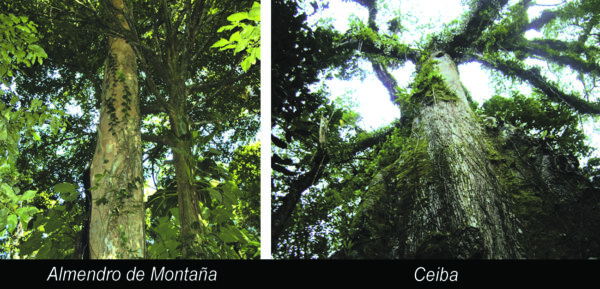
The Sand-box tree is unmistakable because of its thick colum shaped trunk, with light gray bark full of small black thorns curved up as spurs. Its fruits are short curved black as mandarins and when ripe they noisily explode throwing its seeds at long distances. It is found mainly along or near rivers or streams. The Small-leaved Mahogany is a tree of the plains in the Atlantic region that likes to grow in very humid areas. They can grow to more than 40 mts. high and in his thick straight trunk develops shrimp or tabular shaped roots. This species has been commonly used for its reddish wood.
The Gavilan is a species of Oreomunnea very common in the humid forest of the lowlands of the Atlantic region. It has a thick trunk up to just over one meter in diameter, dark coloured, with poorly developed roots and large branches supporting a rather dense tree top which consists of hundreds of leaves composed of tiny leaflets which close at night, a feature called nictinastia.
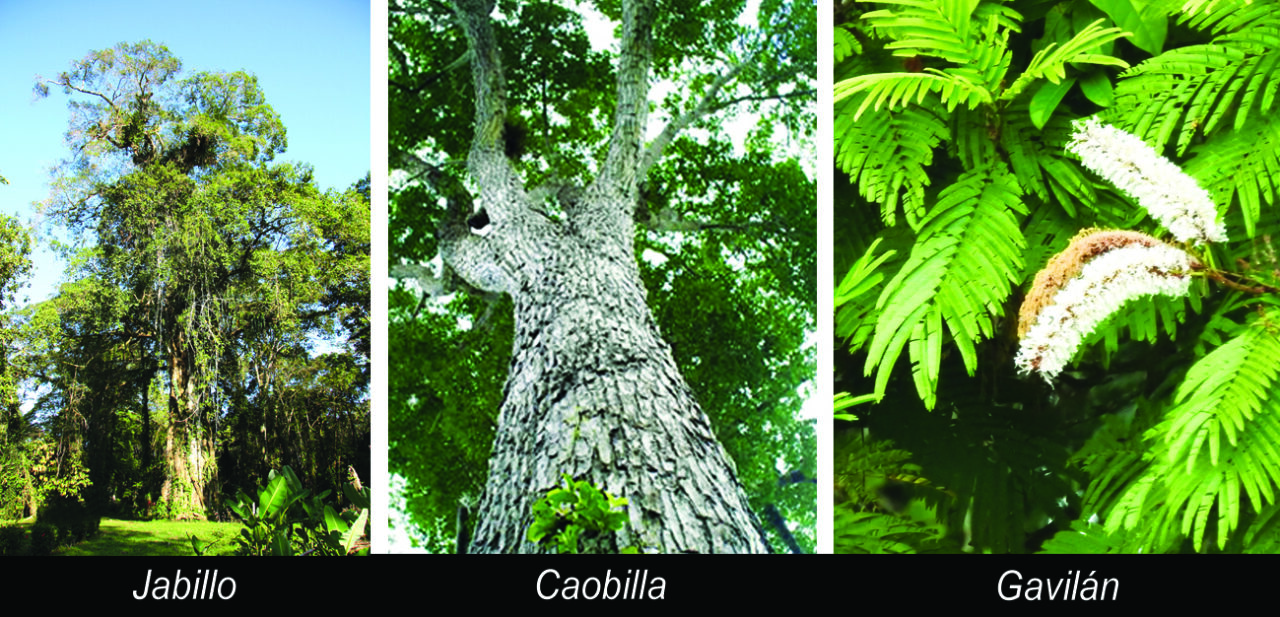

Fotografias de Paco Salmerón
Texto de Juan Carlos Lorite y Paco Salmerón